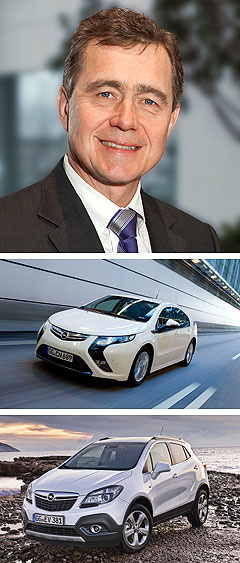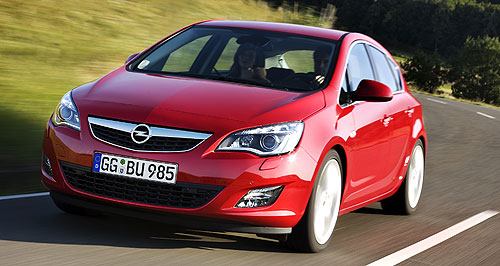Make / Model Search
News - OpelOpel outlines profitability planBack to black: Opel this week laid out 10 measures it will take to speed its return to profitability. Building Chevrolets in European factories part of Opel’s bid for return to profit15 May 2012 UPDATED: 18/05/2012GENERAL Motors’ loss-making European arm Opel plans a quick return to profitability by reducing the cost of building cars, expanding alliances beyond GM’s recent tie-up with PSA Peugeot Citroen, and potentially running factories closer to capacity by building Chevrolets. Opel CEO Karl-Friedrich Stracke yesterday outlined the plan, which also includes a program of new model launches, three new engines and expansion into overseas markets like Australia. Other measures include increasing the profit margin on each vehicle, a new brand strategy aimed at keeping existing customers while appealing to new ones, and expanding its position in the field of alternative propulsion. “We’re very proud that Opel is quite a bit ahead of our competition with products such as the electric Ampera,” Mr Stracke told company employees. An €11 billion ($A14.2b) investment in new products will result in a range renewal that will take Opel through to 2014, with six new models introduced this year alone, including entries to new segments with the Mokka sub-compact SUV and Adam premium-light hatch. A new Astra variant (expected to be a sedan) and “completely new” convertible are also on the launch pad. Opel this week revealed details of a new 1.6-litre turbo-petrol engine that will be joined by two more new powerplants as the company replaces its core petrol and diesel engine line-up.  From top: Opel CEO Karl-Friedrich Stracke, Opel Ampera, Opel Mokka. From top: Opel CEO Karl-Friedrich Stracke, Opel Ampera, Opel Mokka.Mr Stracke said the planned export of cars to Australia, North Africa, South America and the Middle East would not generate enough extra demand to operate its factories at full capacity – and Opel is aiming to run each of its plants around the clock on three shifts. The Astra small car is currently built at three factories running two shifts, so for the next-generation car Opel will produce it at two plants running three shifts, freeing up the third facility. “Given the forecasted market volumes (of the next-generation Astra), it would not be viable to produce in more than two plants,” said Mr Stracke. “If we run these two plants with three shifts, the production costs for the next Astra generation will be significantly below the costs of building the current Astra.” Opel is reviewing the cost of materials that go into its products and is aiming to reduce the complexity of manufacturing them, while working on initiatives to improve quality. The plants chosen to produce the next Astra have not yet been announced, but overseas reports suggest Ellesmere Port in Britain and Giliwice in Poland are most likely, potentially leaving Opel’s home factory Russelsheim to produce other models. Opel considers the Russelsheim plant as playing a key role in its strategy and Mr Stracke described it as the company’s most modern, with an “outstanding workforce” that produces “exceptional quality”. “I want to run this plant on full capacity,” he said. “But Russelsheim also has to remain competitive, and so we have to increase flexibility and significantly reduce our costs per vehicle.” Mr Stracke said Opel is in discussions with Detroit and Shanghai about moving production of some Chevrolet products from South Korea to Europe as a way of boosting production at its factories. He denied the plan is about cutting costs, but quickly improving profitability “irrespective of if and how much the market is going to pick up steam”. “The plan will allow us to significantly increase our margins, market share and sales.” In addition to the product development partnership formed between GM and PSA Peugeot Citroen in March, Opel is open to forging new ones. Mr Stracke assured workers at its international technical development centre in Russelsheim that no jobs will be lost there due to the tie-up, which is designed to slash vehicle costs by $US2 billion within five years. “At the moment we’re at a stage where we’re studying several specific projects with PSA in detail,” he said. “If we decide to move an Opel development project to PSA, then we will balance it by bringing a PSA project to Russelsheim. “Opel is leaving no stone unturned to enhance the efficiency and future viability in order to achieve sustainable profitability as quickly as possible in a difficult market environment.” GM Europe posted a loss of $US256 million in the first quarter of this year, a small improvement on a $US261 million loss for the same period last year, despite selling 14.3 per cent fewer cars. The company said it had sold a higher proportion of more expensive vehicles while reducing manufacturing costs.  Read more15th of May 2012  Opel reveals new engine linesGM Europe brand Opel introduces first of three new engines to be core line-up10th of May 2012  Opel reveals Astra OPC technologyRace-bred diff, frugal but powerful engine and clever chassis for Opel’s Astra OPC9th of May 2012  Opel names premium hatch AdamFounder’s name chosen for Opel’s Mini-rivalling premium hatch due for Paris debut |
Click to shareOpel articlesMotor industry news |











Facebook Twitter Instagram